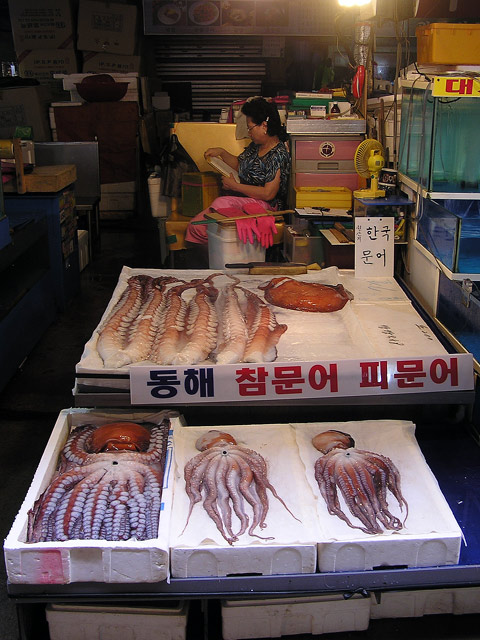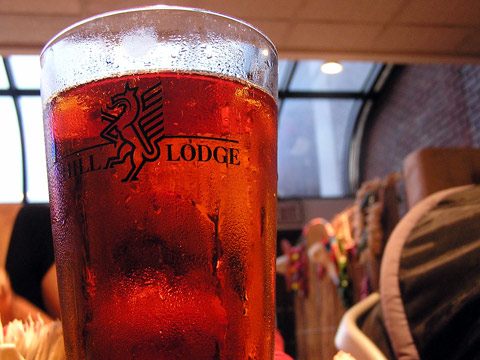Spotted at Binh Tay Market in Saigon, Vietnam. Any help would be much appreciated.
Author Archives →
I ♥ wet season
See also: I ♥ hot season
The Street Sausage of Saigon: Thit Nuong
It helps to be obsessed by a single dish when you arrive in Saigon. I usually hit up a few of my favourite restaurants (the upmarket street food specialist Quan An Ngon, commercial pho franchise Pho 24 anywhere about town) and then am lost in a sea of choice. There’s bun of almost limitless variety, multitude variations on pho, and street food on every corner and clinging to each alleyway. I negotiate these choices by getting momentarily obsessed with seeking out a single dish and then moving on. I felt like thit nuong: casing-free Vietnamese pork sausage, served with the rice noodle bun or in the ultimate Vietnamese sandwich as banh thit nuong; and with this idea for a dish as organising principle, I hit the streets for some local charred charcuterie action.
In the basement of the mall-like Andong market in Cholon is a small concentration of thit nuong vendors, along with the normal assortment of dehydrated animal stalls. I picked the thit nuong vendor that both had the more impressive charred sausage display and laughed the most at me. I’m not really that funny.
The sausage was garlicky and sweetly caramelised, the rest was light on the herbage and bean sprouts but topped with crushed peanuts aplenty. Now, to find a new obsession.
Price: 14,000 VND
Hite touts shite stout
Brewer: The Hite, South Korea
Scouting about for a stout with no clout? Shout for Hite Stout.
There are two things wrong with this stout. Firstly, that it’s black; and secondly, that it is not labelled as “lager” anywhere on the bottle. It is beer at its most deceptive. It’s a brewery’s equivalent of a Decepticon that uses your body to transform back into urine.
ABV: 4.5%
Bad Korean food ideas: Meat in a waffle cone
Not a moment passes when I don’t think that the ultimate summer food experience would be to have a cone of gelati in one hand and a cone of grilled steak in the other. And possibly a third hand for an India pale ale. Despite what fast food companies will have us believe, not every food is designed to be eaten with one hand and I believe that Balena is pushing the boundaries of sanity by presenting Chicken Alfredo in a cone.
See also: Balena website
Noryangjin Fish Market, Seoul
Whenever people describe fish markets, they highlight the predawn chaos and the movement and flow of fish as the only ordered element amongst the pandemonium. I’ve been guilty of it myself. At three o’clock in the afternoon, Noryangjin Fish Market in Seoul is a bastion of calm. The morning crowds have dispersed along with their creels of seafood but the remaining catch appears as fresh (or in many cases, as alive) as it was hours earlier. The occasional browser wanders amongst the aisles of assorted sea creatures in a noncommittal manner; vendors discuss their day, eat a late lunch and share bottles of soju; some prepare for the smallish after work crowd to pick over their remaining wares. There is no compulsion for the hard sell at this time of the day and commerce seems secondary.
Along the Noryangjin Station side of the market is a raised walkway offering birds-eye views of the fishy tableau, along which nestles a line of Japanese and Korean restaurants that capitalise on their proximity to seafood.
Closest to the walkway on the floor of the market seems to house the greatest concentration of live seafood: crabs, fish, shellfish, octopus and other horrors from the Deep.
Octopus come in all dimensions, ranging from thumb-sized to those capable of battling Neptune for undersea supremacy (above).
On the far side of the market from the station, vendors specialise in Korean fish and shrimp pastes in varying degrees of degradation. The focus seems to be on chilli-hot pastes rather than unadulterated salty rotting fish.
The aisles of market stay damp from the melting ice, frequent hosing down and the slosh of fish in tanks. The above pufferfish were more subdued, but were the first that I’ve seen on sale for the purposes of eating, ever.
Shellfish abound in phenomenal variety with bags of clams packed with seawater to keep them alive.
Location: Opposite Noryanjin Station in Seoul, accessible via the raised walkway from the train station.
Korean Street Food Recipes: Hoddeok
Hoddeok is a Winter street food in Korea that is slowly transitioning into year-round fare. In essence, it’s a fried yeast dumpling, flattened to a pancake, with sticky cinnamon sugar centre. From a brief trawl of vendors around Myung-dong, there seemed to be two versions: one fried in a sandwich iron (above) resulting in a crispier outer shell and more consistent disc shape; the other (below), fried and pressed onto a greasy hotplate. Both delicious.
Ingredients – Makes 5
1 1/4 cups plain flour
6 tbsp milk
Pinch of saltTo start the yeast:
1/4 tsp dry yeast
1/4 tsp white sugar
2 tbsp waterStuffing
1/4 tsp cinnamon
5 tbsp brown sugar
Mix the yeast, white sugar and water and leave in a warm place to ferment for 15 minutes. Sieve the flour into a bowl, add the salt, milk and yeasty water. Mix well, cover and leave to rise for two hours. Go see a movie or something.
Mix the cinnamon and brown sugar together for stuffing. Oil up your hands (if not sufficiently oiled from movie popcorn) and take about 1/5 of the dough, flatten into a thick disk and place a tablespoon of stuffing inside. Seal like a dumpling.
Add oil to frypan and heat. Place your sugar filled dumpling into the oil. When brown, turn over and flatten the dumpling into a disk with a spatula. Cook until browned.
US Department of Defense: The Best Brewers in South Korea
The best beer in South Korea is brewed by the US Armed Forces in Yongsan Garrison, dead in the centre of Seoul. The base itself is for all intents, a small American town, albeit an American hamlet with the purpose of keeping the North Koreans in North Korea. There’s a hotel, shopping mall, free cinema, schools, a Taco Bell next to the Starbucks, a Harley-Davidson salesman, lawn-fringed beige houses that look transplanted from some faceless Midwest American exurb. An arms contractor had set up display tents in front of mall; soldiers on lunchbreak pawed at the heavy automatic weapons and stared down high-powered scopes at a Lexus in a distant parking lot. Soldiers bought American taxpayer-subsidised Xboxes and Clinique cosmetics inside the US Army’s perfect simulation of Wal-Mart. Transactions were in US Dollars only, the Korean Won unsuitable as currency. The church had a signboard advertising its summer Bible camp.
Save for the large number of camouflaged American inhabitants, jarhead haircuts and the flagrant display of high-tech killing machines, the base looks like one of the many gated communities that are spreading throughout the outskirts of Southeast Asia’s major cities: those new ghettoes of the freshly-minted Asian middle class who are just as scared of the inner city as their Western counterparts. It’s a strange place to exist in the centre of the Korean metropolis, all the more stranger that they are brewing amber ale.
Dragon Hill Lodge on the base is one of four luxury hotels owned by the US Department of Defense, built to serve holidaying active and retired military members and their families. Originally established as Hartnell House in Pusan in 1950, during the course of the Korean War it has been shifted between Taegu to Seoul several times before being laid to rest on Dragon Hill. While it was purpose-built as an Armed Forces luxury hotel, a few of the older red brick offices still in use on the camp were built by the Japanese, who occupied Korea from 1910 to 1945. The new foreign protectors taking the place of the old colonisers may have made tactical sense but for the previously colonised, it must look like business as usual. As a commercial enterprise, the hotel can’t be faulted. Last year it earned millions for America’s army and does business of a similar magnitude to its family of “Armed Forces Recreation Centers” in Germany, Hawaii and Disneyworld, Florida.
In the basement of Dragon Hill lies Oasis Restaurant, an ersatz Tex-Mex outlet. Their all-you-can-eat buffet runs the gamut of tortillas, guacamole, frijoles, Texas-style hickory smoked pork ribs with a choice of three barbecue sauces, Buffalo wings and burgers. Lobster was on special. Cola comes served in individual pitchers for each diner. Their amber ale is a genuine surprise, soldiers being enterprising but somewhat unconventional brewers.
When I was doing a little research on Grape Nuts for a previous blog post, I came across a rumour that during the Gulf War, US Armed Forces went a little crazy for the Nuts. While I couldn’t find anyone to confirm it with, Grape Nuts make a serviceable substitute for malt when attempting to brew beer under desperate lager-free combat circumstances. The Gulf being both a beer- and malt-free environment, bored soldiers stationed in the endless desert ordered and consumed tons of Grape Nuts. Yeast can be collected from either the air, sourdough-style; or fermented from bread. To substitute for hops, you would need a bittering agent of any description. Mix it all together with water in a clean jerry can with a makeshift airlock and in a few weeks it would make for a grisly ale, but ale nonetheless. Armies do not tend to be valued for their brewing prowess but their ingenuity cannot be faulted, which is why Dragon Hill Amber Ale is such a brilliant display of nonconformity to character.
The ale misses a good head but is packed full of malt and a jolting dose of fragrant hops, with a little aluminium flavour on the back palate. It’s a beer that for a moment makes you forget that you’re in Korea, fighting a war where there hasn’t been a casualty in years, staring north at an enemy who is busy both starving to death and targeting you, in the middle of a transplanted Middle American town.
















